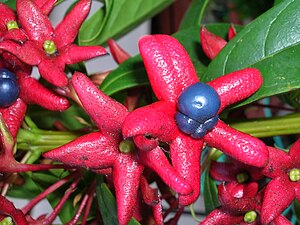Note: This is a project under development. The articles on this wiki are just being initiated and broadly incomplete. You can Help creating new pages.
Clerodendrum indicum - Bharangi, Tubeflower
Clerodendrum indicum is a semideciduous, perennial plant with stems that are sometimes herbaceous but more often become woody, with the plant adopting the habit of a shrub or a small trre. Growing from an aggressively suckering, stoloniferous rootstock, the plant can be up to 3 metres tall, the stems usually very straight or arching, mostly unbranched, hollow.
Contents
- 1 Uses
- 2 Parts Used
- 3 Chemical Composition
- 4 Common names
- 5 Properties
- 6 Habit
- 7 Identification
- 8 List of Ayurvedic medicine in which the herb is used
- 9 Where to get the saplings
- 10 Mode of Propagation
- 11 How to plant/cultivate
- 12 Commonly seen growing in areas
- 13 Photo Gallery
- 14 References
- 15 External Links
Uses
Asthma, Skin problems, Coughs, Syphilitic rheumatism, Abdominal tumors, Tuberculosis, Chronic respiratory disorder, Jaundice, Disorder of liver, Joint pain, Headache, Worm infetsation, Digestive fire.
Parts Used
Chemical Composition
Common names
| Language | Common name |
|---|---|
| Kannada | angaravalli, baaleya, bangaali bhaarangi |
| Hindi | barangi, chingari |
| Malayalam | cerutekku |
| Tamil | isangu, kavalai, kovalai, narivalai |
| Telugu | bhaarangi, bharangi |
| Marathi | NA |
| Gujarathi | NA |
| Punjabi | NA |
| Kashmiri | NA |
| Sanskrit | bhargi, bharngi, brahmanyastika, phangi |
| English | Tubeflower, Turk's-Turban, Sky Rocket, Bowing Lady |
Properties
Reference: Dravya - Substance, Rasa - Taste, Guna - Qualities, Veerya - Potency, Vipaka - Post-digesion effect, Karma - Pharmacological activity, Prabhava - Therepeutics.
Dravya
Rasa
Guna
Veerya
Vipaka
Karma
Prabhava
Habit
Identification
Leaf
| Kind | Shape | Feature |
|---|---|---|
| Paripinnate | Oblong | Leaf Arrangementis Alternate-spiral |
Flower
| Type | Size | Color and composition | Stamen | More information |
|---|---|---|---|---|
| Unisexual | 2-4cm long | pink | Flowering throughout the year and In terminal and/or axillary pseudoracemes |
Fruit
| Type | Size | Mass | Appearance | Seeds | More information |
|---|---|---|---|---|---|
| oblong pod | Thinly septate, pilose, wrinkled | seeds upto 5 | Fruiting throughout the year |
Other features
List of Ayurvedic medicine in which the herb is used
Where to get the saplings
Mode of Propagation
How to plant/cultivate
Succeeds in a moderately to very sunny position in ordinary garden soil[3]
Commonly seen growing in areas
tropical region, Temperate region, hammocks.
Photo Gallery
References
- ↑ ["Chemistry"]
- ↑ [ "Morphology"]
- ↑ "Cultivation detail"
External Links
- Ayurvedic Herbs known to be helpful to treat Asthma
- Ayurvedic Herbs known to be helpful to treat Skin problems
- Ayurvedic Herbs known to be helpful to treat Coughs
- Ayurvedic Herbs known to be helpful to treat Syphilitic rheumatism
- Ayurvedic Herbs known to be helpful to treat Abdominal tumors
- Ayurvedic Herbs known to be helpful to treat Tuberculosis
- Ayurvedic Herbs known to be helpful to treat Chronic respiratory disorder
- Ayurvedic Herbs known to be helpful to treat Jaundice
- Ayurvedic Herbs known to be helpful to treat Disorder of liver
- Ayurvedic Herbs known to be helpful to treat Joint pain
- Ayurvedic Herbs known to be helpful to treat Headache
- Ayurvedic Herbs known to be helpful to treat Worm infetsation
- Ayurvedic Herbs known to be helpful to treat Digestive fire
- Herbs with Seeds used in medicine
- Herbs with stem used in medicine
- Herbs with leaves used in medicine
- Herbs with Root used in medicine
- Herbs with common name in Kannada
- Herbs with common name in Hindi
- Herbs with common name in Malayalam
- Herbs with common name in Tamil
- Herbs with common name in Telugu
- Herbs with common name in Sanskrit
- Herbs with common name in English
- Habit - Shrub
- Index of Plants which can be propagated by Seeds
- Index of Plants which can be propagated by Root cuttings
- Herbs that are commonly seen in the region of tropical region
- Herbs that are commonly seen in the region of Temperate region
- Herbs that are commonly seen in the region of hammocks
- Herbs




